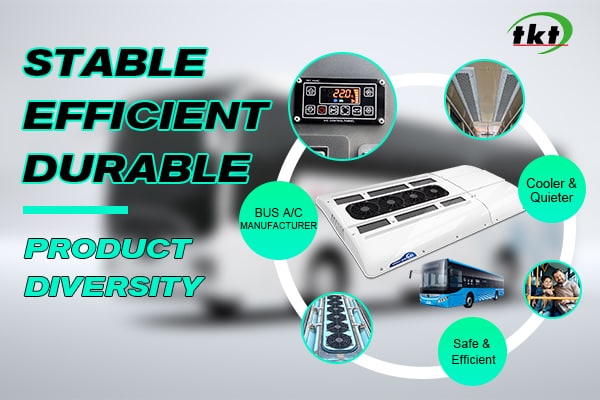Výběr správného klimatizačního systému pro váš autobus je zásadní pro zajištění pohodlné jízdy pro cestující, zvláště během horkého počasí. S nepřeberným množstvím dostupných možností, může být zdrcující určit, který systém nejlépe vyhovuje vašim potřebám. V tomto obsáhlém průvodci, se ponoříme do různých typů klimatizačních systémů autobusů, jejich součásti, výkonnostní standardy, a jak vybrat nejúčinnější a nejekonomičtější variantu pro vaše vozidlo.
Pochopení klimatizačních systémů autobusů
Types of Air Conditioning Systems
Bus air conditioning systems can be categorized into two primary types: Original Equipment Manufacturer (OEM) systems and aftermarket systems.
– OEM Systems: These systems are integrated into the bus during its assembly. They are designed to work seamlessly with the bus’s existing HVAC systems, ensuring optimal performance and reliability.
– Aftermarket Systems: Installed post-production, these systems can either be tied into the existing dashboard HVAC systems or function as standalone units. They offer flexibility and can be tailored to specific cooling requirements.
Přes minulost 24 let, TKT EV Solution has grown to be the OEM of choice for 100% čínských autobusových klimatizací a systémů tepelného managementu baterií, jako je Yutong, Nanjing Jinlong, Xiamen Jinlong, atd. (Bus Air Conditioners), CIMC, Xinfei, Hongyu, atd. Na mezinárodním trhu, TKT is the OEM of Tata Motors, Chůva Marco Polo, Daewoo Motors, atd., a exportuje do přes 85 zemí s prodejními a servisními centry.
Klíčové komponenty
A high-quality bus air conditioning system comprises several crucial components:
– Kompresor: The heart of the system, typically mounted on the engine or a separate power source, compresses the refrigerant and circulates it through the system.
– Výparník: Located in the driver’s area or throughout the bus, the evaporator cools the air by absorbing heat.
– Kondenzátor: Mounted on the roof or skirt, it releases the absorbed heat to the outside air.
– Controls: These include switches, thermostats, and electronic controls to manage the system’s operation.
– Additional Evaporators: These can be hanging or flush-mounted, ensuring uniform cooling throughout the bus.

Selecting the Right System
Performance Standards
When selecting an air conditioning system for ev buses, it is essential to consider the performance standards set by industry authorities. The National Congress of School Transportation and the American Public Transit Association provide guidelines to ensure systems meet minimum cooling requirements.
– National School Bus Specifications:
— Standard Performance: The system should cool the interior from 100°F to 80°F within 30 minut.
— High Performance: The system should cool the interior from 100°F to 70°F within 30 minut.
– American Public Transit Association Specifications:
— Capacity and Performance Requirements: The system should reduce the passenger compartment temperature from 115°F to 95°F within 20 minutes after engine startup.
— Hotter Ambient Conditions: The system should reduce the temperature from 110°F to 70°F (±3°F) within 30 minutes for 30-, 35-, and 40-foot buses.
BTU Capacity Considerations
Understanding BTU (British Thermal Unit) capacity is crucial in evaluating the effectiveness of an AC system unit. BTU měří množství tepla potřebného ke zvýšení teploty jedné libry vody o jeden stupeň Fahrenheita.
– Hrubá kapacita: Toto je nejnižší kapacita mezi výparníky, kondenzátor, a kompresor, představující nejslabší článek systému.
– Čistá kapacita: I když málo používané, tato metoda využívá několik simultánních rovnic k vyvážení systému.
Je důležité poznamenat, že v odvětví klimatizace autobusů neexistuje žádná univerzální metoda hodnocení BTU. The most reliable way to assess a system’s performance is through a pull-down test, where the system’s ability to cool the bus interior is measured under specified conditions.
Practical Recommendations
– Work with Your Dealer: Collaborate with your dealer to select a system tailored to your bus’s cooling needs. Consider the power draw of the system to ensure it does not overburden the vehicle’s alternator capacity.
– Performance Pull-Down Test: Require a performance pull-down test to evaluate the system’s ability to cool the bus interior effectively.
– Standardized BTU Ratings: Insist on BTU/hour capacities recorded in an industry-standard format, such as those provided by the Society of Automotive Engineers (SAE).
Závěr
Choosing the right air conditioning system for your bus requires careful consideration of various factors, including system type, components, výkonnostní standardy, and BTU capacity. By adhering to industry guidelines and working closely with your dealer, you can ensure that your bus is equipped with an efficient and effective cooling system, providing a comfortable environment for passengers and enhancing the overall travel experience.



